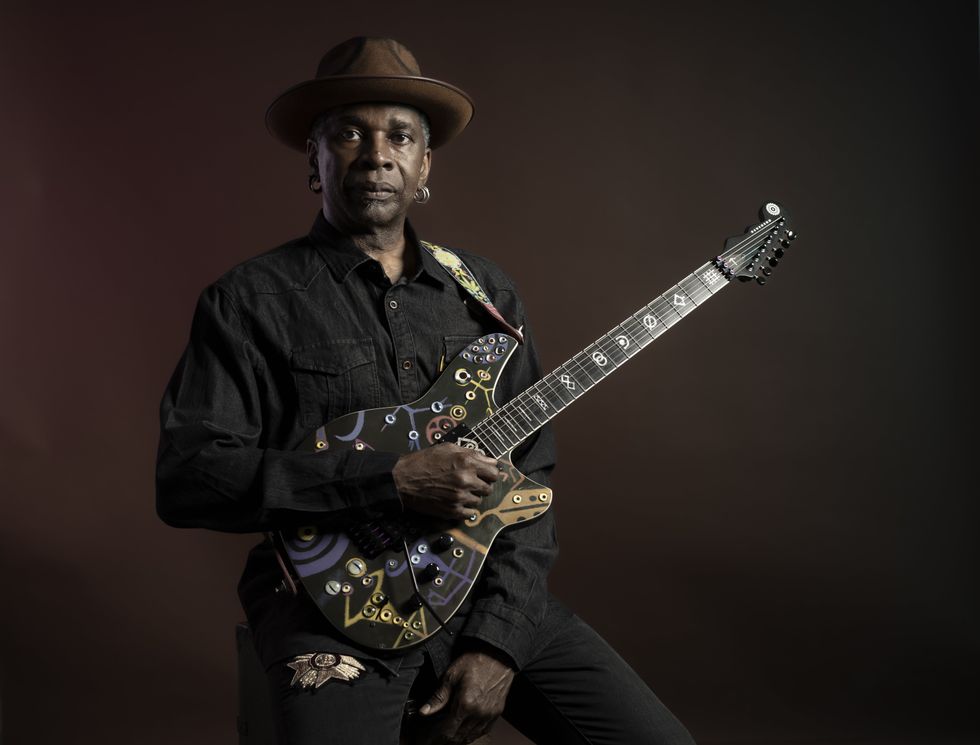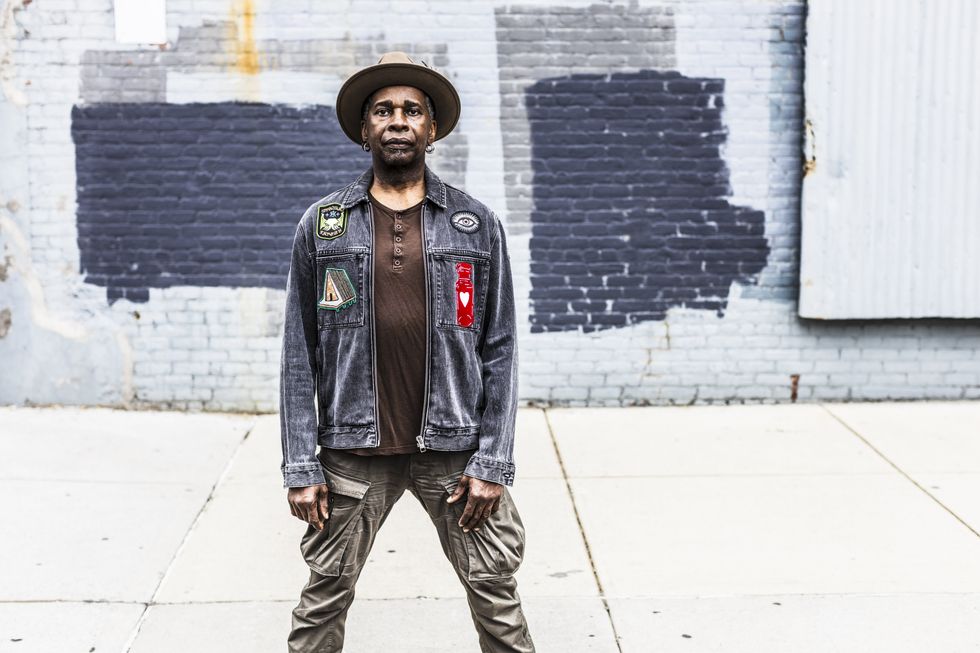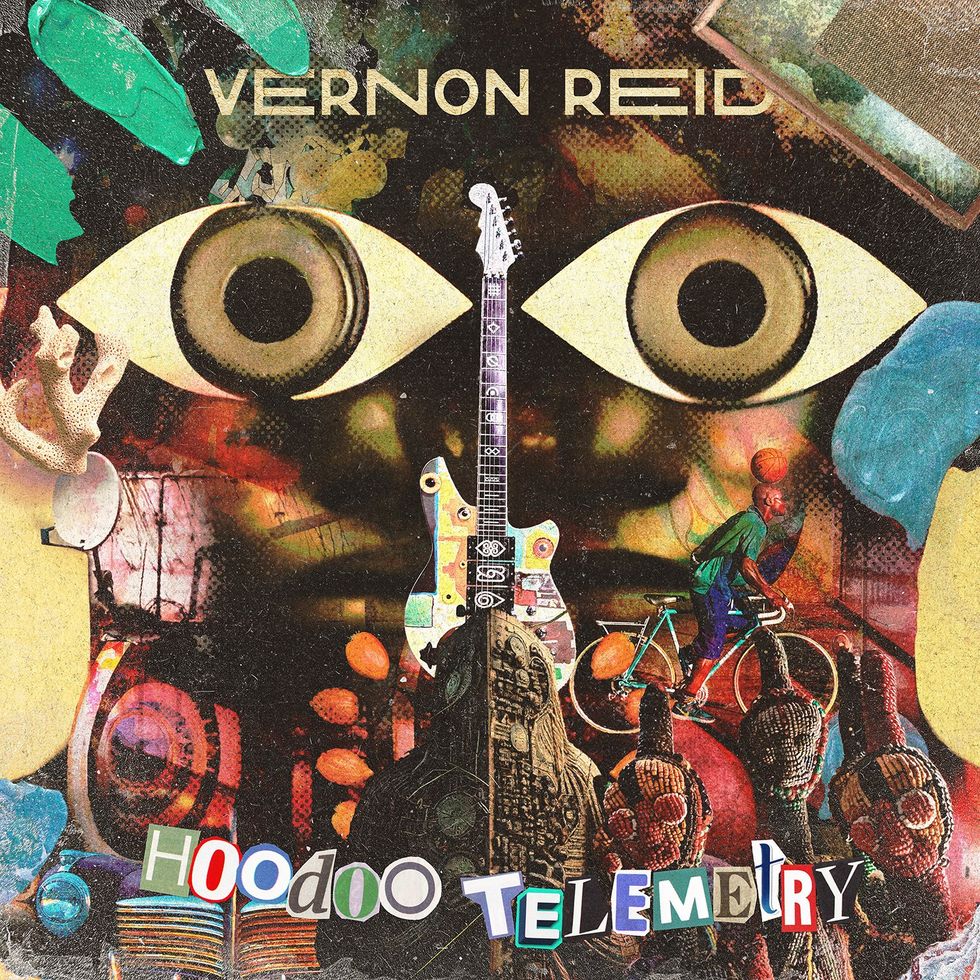“We don’t consider ourselves politicians or into politics by any means, but the sense of national unrest, and the unwillingness to work together, it’s really grated on us,” admits Killswitch Engage guitarist/producer Adam Dutkiewicz (Adam D, professionally). “It’s manifested itself into the songs and lyrics.”
As a result, Killswitch Engage’s ninth full-length LP, This Consequence, has all the hallmarks of a band meeting its moment. It’s been nearly a quarter-century since they released their eponymous debut, and they’ve subsequently achieved a career-sustaining amount of success as one of the main architects of the metalcore genre, but This Consequence is likely their first album to highlight such a clearly articulated, socially conscious through line.
Lyrically, cause-and-effect is a driving theme on This Consequence, and Killswitch Engage (KSE) captures the zeitgeist of the 2020s with incisive, often cautionary, commentary regarding topics like war, hatred, division, and falling in line. Musically, the band has channeled those same sources of inspiration into performances that feel more urgent, and thus more sincere, creating a viscerally brutal yet brilliantly melodic slab of postmodern metalcore. KSE has long held a reputation for having a good time and riling up crowds with uncontainable energy and unpredictable performances, but it’s been hard to ignore the degradation of discourse in this country over the last decade, even for these renowned ringmasters.
KSE was formed in 1999 in Westfield, Massachusetts, from the remnants of Overcast and Aftershock, two prominent local metal bands. KSE’s early lineup featured founding members Dutkiewicz on drums and Mike D’Antonio on bass, along with vocalist Jesse Leach and guitarist Joel Stroetzel. The fledgling band quickly gained attention for its mix of melodic and death-metal influences: a musical amalgamation that would become the template for metalcore. The band’s second album, 2002’s Alive or Just Breathing, was pivotal, marking a major shift in their sound and identity, with a dual-guitar attack leading the charge. In order to accurately render that album in concert, Dutkiewicz switched to guitar, and they brought in Tom Gomes on drums. The record includes some of the band’s most iconic songs to date, including, “My Last Serenade,” “Fixation on the Darkness,” and “The Element of One.” Adopting a two-guitar approach was a masterstroke and Alive or Just Breathing has since become one of metalcore’s most definitive albums, blending deft, tightly synchronized guitar riffs with battering rhythms, guttural verses, melodic choruses, and a hardcore punk attitude. It was a winning formula that enabled KSE to build a huge fan base.
“Everything I bring to the table, I tell them, ‘We can throw it away.’”–Adam Dutkiewicz
In 2004, they released The End of Heartache, their first to feature Howard Jones on lead vocals and Justin Foley on drums. The album reached No. 21 on the Billboard 200 and earned a Best Metal Performance Grammy nomination for the title track. Songs like “When Darkness Falls” and “Rose of Sharyn” continued to elevate KSE’s status within the metalcore hierarchy. In 2009, Jones left and Leach returned. Disarm the Descent was released in 2013 and debuted at No. 7 on the Billboard 200, marking the band’s highest charting debut to that point. Incarnate followed in 2016, and then Atonement, their first release on Metal Blade, in 2019. KSE was on a roll with Leach firmly back in the fold, and ready to tour when the pandemic struck. During the downtime, inspiration hit, so they regrouped, wrote, rehearsed, and eventually recorded This Consequence. Songs like “Aftermath,” “Abandon Us,” and “Broken Glass” exemplify the kind of relatable cultural commentary that can be cathartic for today’s disenfranchised—especially when paired with the band’s other equally memorable musical attributes.
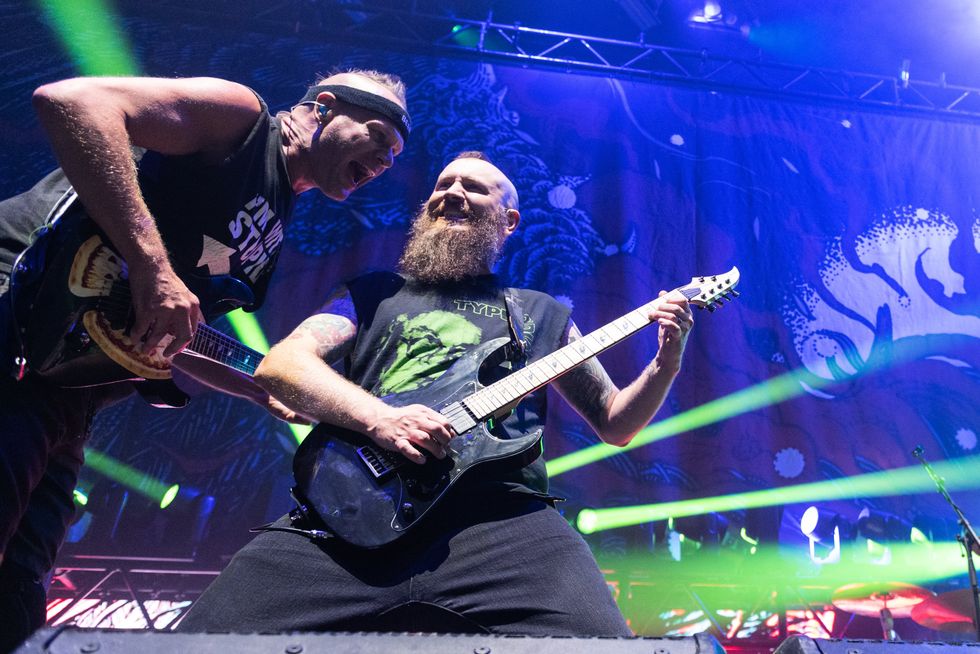
In riffs they trust: Killswitch Engage’s Adam Dutkiewicz (left) and Mike Stroetzel prefer strong, arranged guitar parts that create scenes within arrangements, rather than flash shredding.
Photo by Mike White
The writing and rehearsal process for This Consequence was the first time since Alive or Just Breathing that all five members convened in a studio to work out the material before recording. Like many artists nowadays, KSE had been writing and recording remotely for at least the last decade. Stroetzel says it was great to be able to work on the tunes together, in the same room, and that, musically, it allowed the arrangements to come together a little bit faster. “Especially the songs that were only partially finished,” chimes in Dutkiewicz. In addition to his role on guitar, Dutkiewicz has been the band’s producer—his major at Berklee—almost since inception. Perhaps having a skill set with that kind of overview is why he’s also the only member of the group to craft fully fleshed-out songs on his own. And yet, even he recognizes how his material benefitted from their rehearsal process this time. “It was really good for everybody in the band to get their hands on their instruments, learn the riffs, and then tweak them to their level of comfort,” he says. “They’re more invested in the song that way because their voice and their sound is on it. And when we play the song live, it’s more their song, instead of that song that Adam wrote.”
“A tight staccato section needs a wide, harmonically rich section to complement it. We try our best to have scenes in a song like that.”–Adam Dutkiewicz
The cultural continuity of the lyrics on This Consequence didn’t just come about by happenstance, either. It’s not a concept album per se, but the band encouraged Leach to continually refine his lyrics and elevate his ideas and topics. “When you’re writing lyrics for that many songs at once, it’s easy to fall into the tendency of writing about the same topics, with the same vibe,” says Dutkiewicz. “He just needed to try something completely different.” As a result, Leach tapped into his own angst about the current state of world affairs, bestowing upon This Consequence the kind of social relevance that previous KSE albums never quite captured so succinctly. “Jesse gets the gold star for trying the hardest,” commends Dutkiewicz.
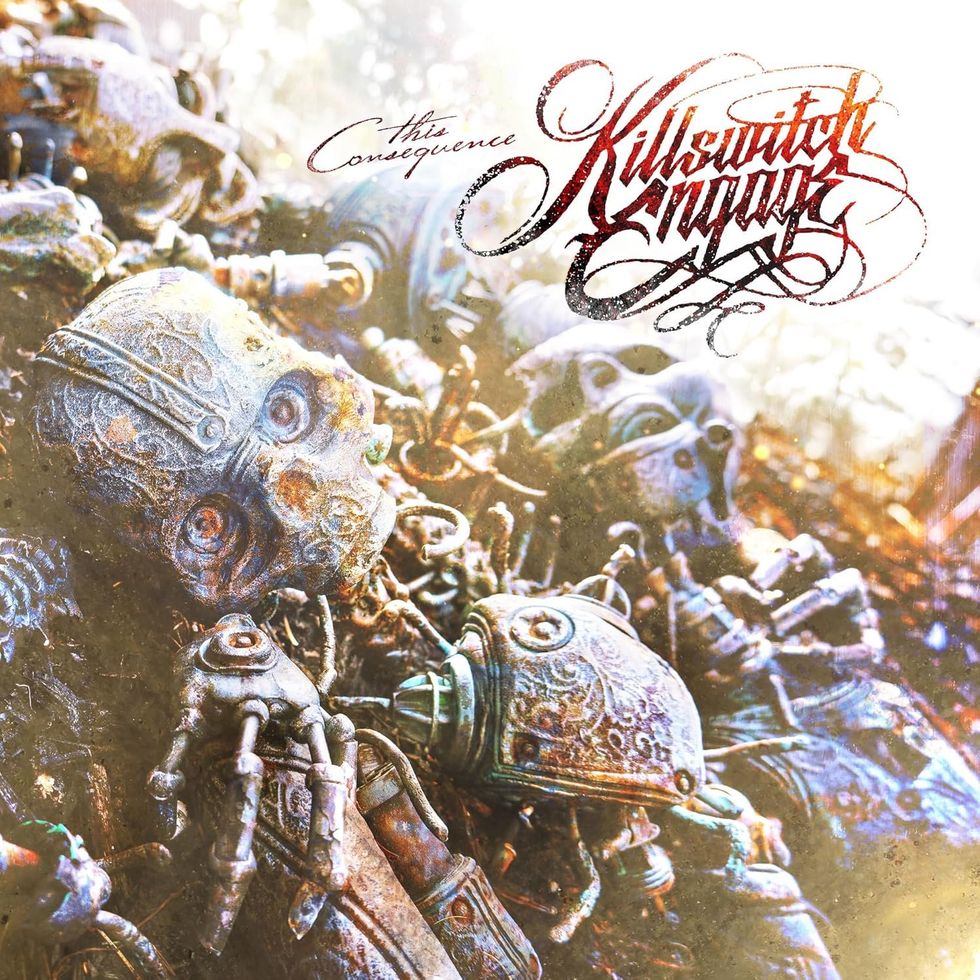
Per usual, Adam Dutkiewicz served as producer for the new album, but engineer Mark Lewis at MRL Studios in Nashville, Tennessee, played a significant role in determining its final sonic character.
Dutkiewicz isn’t particularly attached to his own musical ideas or songs and admits he’s willing to deconstruct just about anything for the good of the group, even after he’s submitted a complete demo to the rest of the guys. “Everything I bring to the table, I tell them, ‘We can throw it away.’ I think a big part of being an artist is just the creation of things and sometimes the destruction of things.” Dutkiewicz’s willingness to analyze material from that perspective is part of what makes him such a good de facto producer for the band. “It’s just not having an ego about anything,” he says. “You always have to remember you have to do what’s best for the song and not for my riff.” Another theme that runs through KSE songs on This Consequence, and in general, is how their arrangements work. They employ a visual, almost cinematic approach to production and songcraft. “It’s almost like you want scenes in a song,” explains Dutkiewicz. “A tight staccato section needs a wide, harmonically rich section to complement it. We try our best to have scenes in a song like that.”
“We play together a little behind the beat now. Before, we were fighting each other a little bit.”—Joel Stroetzel
Dutkiewicz and Stroetzel have been playing guitar together since long before the release of Alive or Just Breathing, mostly because the former has always worn multiple hats within the band, and share many of the same influences, including Megadeth, Slayer, Testament, Sepultura, and especially Metallica. They both credit James Hetfield for setting the bar when it comes to their own obsession with fast, articulate rhythm-guitar playing. As Stroetzel got older he gravitated towards classic rock, especially Jimi Hendrix and Led Zeppelin. “Now I can play things other than metal,” he jokes. Dutkiewicz, on the other hand, got into the classic stuff at a younger age, citing his early infatuation with Eddie Van Halen and Angus Young. “It’s more so Angus Young’s spirit and onstage attitude,” he clarifies. Dutkiewicz’s high-energy stage presence validates that sentiment.
Adam Dutkiewicz’s Gear
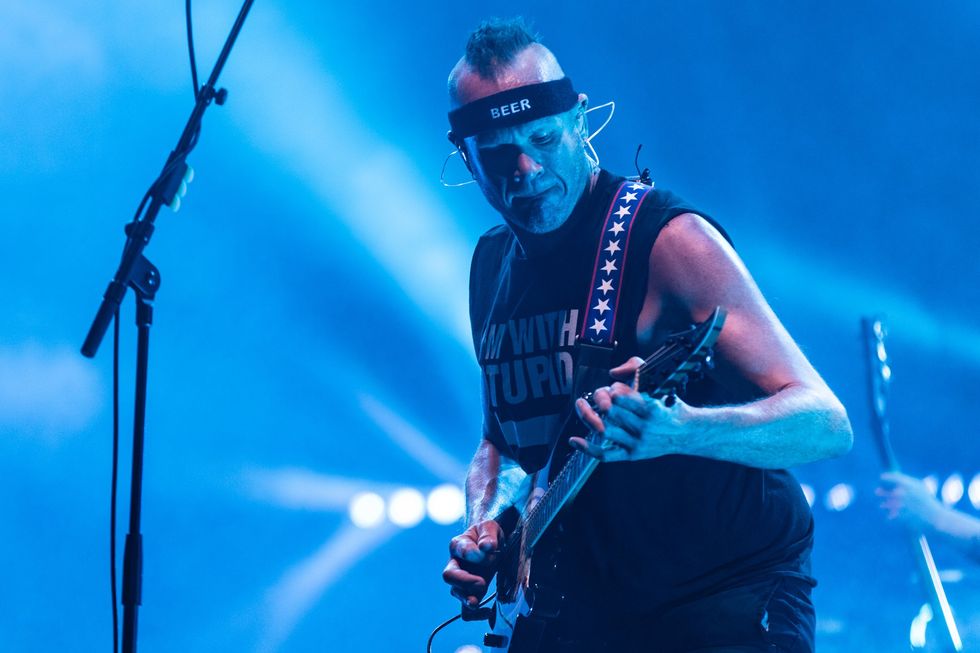
Adam Dutkiewicz, telegraphing his love of suds, onstage at Los Angeles’ Wiltern Theatre in February 2022, playing his Caparison TAT Special FX “Metal Machine” with Fishman Fluence Signature Series Killswitch Engage Pickups.
Photo by Debi Del Grande
Guitars
- Caparison TAT Special FX “Metal Machine” with Fishman Fluence Signature Series Killswitch Engage Pickups
Amps
- Kemper Profiler
- Kemper Stage
- Mesa/Boogie 4x12 cabs with Celestion speakers
Effects
- Electro-Harmonix Magnum 44 Power Amp
- Maxon OD808 Overdrive
Strings, Picks, Microphones, &
Accessories
- D’Addario EXL115 XL Nickel Wound (.011– .049)
- In-Tune XJ Jazz 1.14 mm
- Shure ULXD and GLXD wireless systems
- sE V7 Dynamic Microphones
- D’Addario Planet Waves cables
Stroetzel confesses that it took some time to develop into the symbiotic guitar tandem that’s become a signature musical element of the KSE sound. “We play together a little behind the beat now,” he explains. “Before, we were fighting each other a little bit. I always thought Adam had a very forward style with his picking, but he’s mellowed over the years. I had to pick up the pace a little, Adam relaxed a little bit, and I think we found a happy midpoint. It only took 25 years [laughter].” Part of the challenge has been adapting to how the other person writes. “I struggle with some of Joel’s articulate phrasing sections,” explains Dutkiewicz. “I’m just a big mangler and he’s got these well-phrased sections. And I’m just like, ‘God, ah.’ He plays a lot more guitar than me, so his string skipping and pick phrasing is way beyond what I’m capable of doing.” Stroetzel says he struggles with some of Dutkiewicz’s chord voicings because he has such big hands. “Some of these chords he can reach, I’m like, ‘Man, how do you even do that?’”
“Just hearing the Kemper for the first time, and what it could actually do, was pretty impressive, especially for high-gain tone.”—Joel Stroetzel
Surprisingly, however, they don’t actually even take guitar solos in the traditional sense. “We’re not necessarily looking to throw leads on everything,” admits Dutkiewicz. “To us, it’s just a musical interlude. You can’t have vocals [constantly] for three minutes and 30 seconds, so it’s just a quick little side journey in the song.” One of the closest things to an actual guitar solo is probably on the opening track “Abandon Us,” right after the first chorus, which features the nimble-fingered fretwork of Dutkiewicz, but even that’s more like a short detour than a bona fide lead break. Instead, they tend to incorporate a lot of Thin Lizzy/Iron Maiden-style harmony parts and deploy single-note phrases, counter melodies, and sub-hooks to the vocals in bridges and choruses, weaving a layered tapestry of melodic ear candy. Songwriting is ultimately their primary focus, and the songs are relatively short and to the point for a metal band, so there doesn’t seem to be a need to clutter things up with unnecessary solos. When it comes to crafting such parts, the general rule of thumb for assigning these melodious forays is whoever writes the song, or initiates the song idea, does the honors. And so, songs like “Discordant Nation,” “I Believe,” and “Requiem” highlight Stroetzel’s nuanced lyrical phrases, while “Abandon Us” and “Where It Dies” feature Dutkiewicz’s more shred-like soloing style.
When it comes to tone, Stroetzel in particular remains a big fan of tube amps, and the band has a long history of utilizing heads from boutique manufacturers like Diezel, Framus, and Friedman. In recent years, however, software sounds have gotten much better, and they’ve gravitated towards profiling amps and plugins, especially live. “Just hearing the Kemper for the first time, and what it could actually do, was pretty impressive, especially for high-gain tone,” explains Stroetzel. “If you want an aggressive metal tone, I think the Kemper does a nice job capturing that, and it works great live—we’re consistent from night to night.” And besides, they both openly admit it’s not like KSE requires a lot of nuanced technique. “We don’t have very delicate parts in our songs,” jokes Dutkiewicz. “Even our clean tones aren’t very touch sensitive.”
Joel Stroetzel's Gear

Joel Stroetzel, here, and Adam Dutkiewicz both play signature-model Caparison guitars. Stroetzel’s is a Dellinger-JSM V2.
Photo by Debi Del Grande
Guitars
- Caparison Dellinger-JSM V2 with Fishman Fluence Signature Series Killswitch Engage Pickups
Amps
- Kemper Profiler
- Kemper Stage
- Mesa/Boogie 4x12 cabs with Celestion speakers
Effects
- Electro-Harmonix Magnum 44 Power Amp
- Maxon OD808 Overdrive
Strings, Picks, Microphones, &
Accessories
- D’Addario EXL115 XL Nickel Wound (.011–.049)
- D’Addario Duralin Black Ice 1.10 mm
- Shure ULXD and GLXD wireless systems
- sE V7 Dynamic Microphones
- D’Addario Planet Waves cables
Dutkiewicz says that what listeners end up hearing, tone-wise, is ultimately up to whoever mixes the album, which, in the case of This Consequence, was Mark Lewis at MRL Studios in Nashville, Tennessee. Aside from that, everything else is very cut-and-dried. Stroetzel says there’s always a Maxon OD808 on everything they do that’s dirty. “Throw a little bit of that boost in there, and it just kind of compresses the tone a little bit and brings out the midrange a little more,” he explains. “And then, all we really need is a noise gate. That’s it.” They both play Caparison signature model guitars, incorporating elements of other instruments they’ve played over the years. “I’ve always liked Fender-style guitars—Strats and Teles,” says Stroetzel. “So, my signature model is constructed with those in mind, but to sound a little bit thicker and have some thunder in the low end, like a hot-rod metal guitar.” Dutkiewicz says his guitar was designed with simplicity in mind. “I was ruining guitars on tour,” he admits. “I had a bolt-on once, and my sweat got into the bolt holes and it actually rotted out. I couldn’t believe it. Sweat was getting in the cavity of the guitar, and it was cutting out the pickups and causing corrosion on the electronics inside. So, I got rid of the neck pickup and made it a neck-through. I’m a mangler, so it’s loud, bright, and obnoxious, just like me [laughter].”
As for their revered place in the pantheon of metalcore, Stroetzel takes the humble approach, as many in his position often do, saying they’re not really concerned with putting a label on KSE. “We all just try to put in elements of what we like,” he says. “Everybody in the band has listened to so many different types of music over the years. It’s like, ‘Who cares if this is a hardcore song or a thrash song?’ It doesn’t really matter. I don’t think we’ve ever tried to stick to a specific style. We’re just a rock band.”
YouTube It
In this full-set performance from 2023’s Wacken Open Air festival in Itzehoe, Germany, Killswitch Engage dances the line between beauty and brutality.
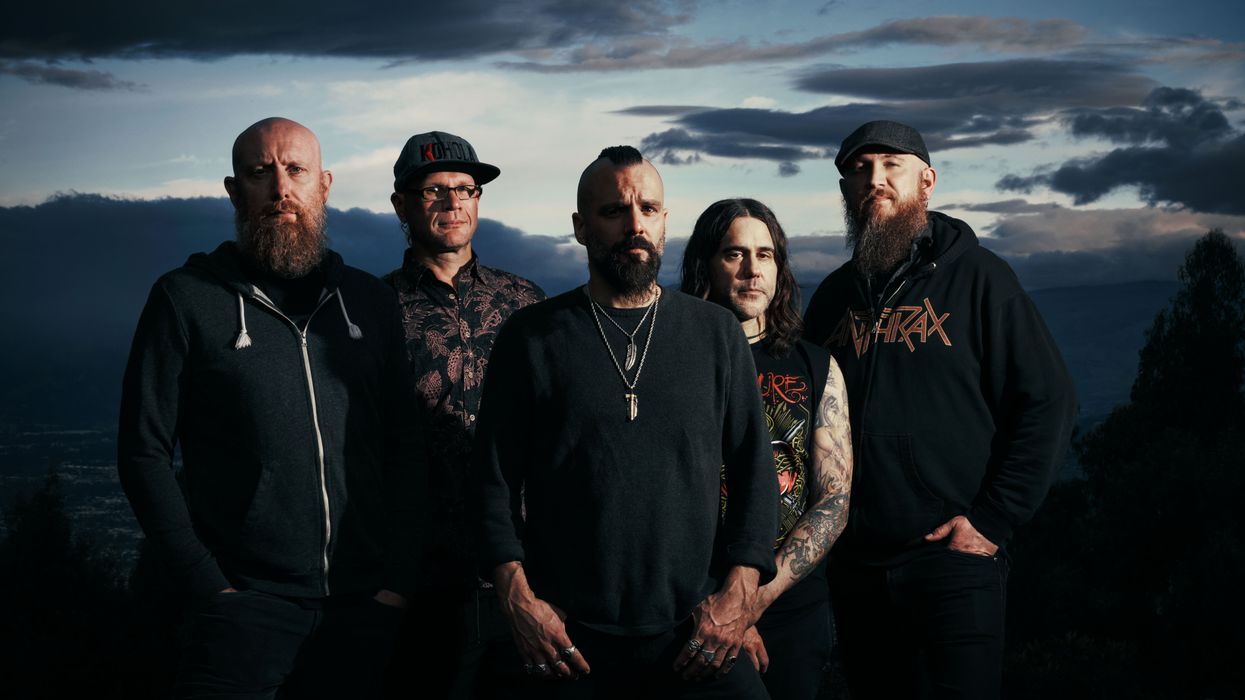


















![Devon Eisenbarger [Katy Perry] Rig Rundown](https://www.premierguitar.com/media-library/youtube.jpg?id=61774583&width=1245&height=700&quality=70&coordinates=0%2C0%2C0%2C0)











